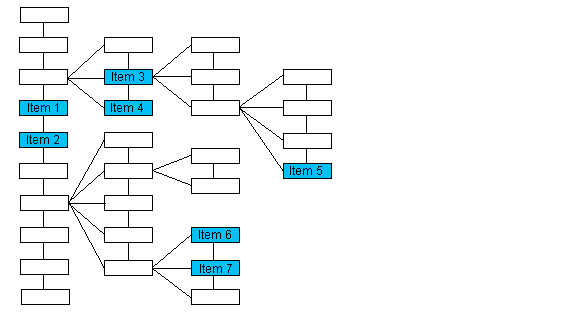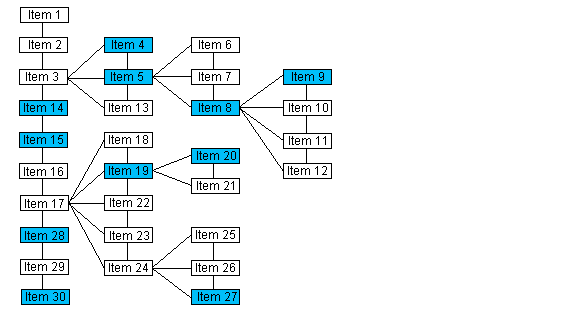| LEADTOOLS DICOM C DLL Help > Function References > L_DicomGetNextElement |
#include "Ltdic.h"
L_LTDIC_API pDICOMELEMENT L_DicomGetNextElement(hDS, pElement, bTree, bVolatile)
|
HDICOMDS hDS; |
/* a DICOM handle */ |
|
pDICOMELEMENT pElement; |
/* pointer to a DICOMELEMENT structure */ |
|
L_BOOL bTree; |
/* flag that indicates how to evaluate the Data Set */ |
|
L_BOOL bVolatile; |
/* flag that indicates the type of element to retrieve */ |
Returns a pointer to the item in the Data Set that immediately follows the specified item.
|
Parameter |
Description |
|
|
hDS |
A DICOM handle. |
|
|
pElement |
Pointer to a DICOMELEMENT structure that contains an item in the Data Set. A pointer to the item in the Data Set that immediately follows this item will be returned. |
|
|
bTree |
Flag that indicates how the Data Set will be evaluated. Possible values are: |
|
|
|
Value |
Meaning |
|
|
TRUE |
Evaluate the Data Set as a tree. |
|
|
FALSE |
Evaluate the Data Set as a list. |
|
bVolatile |
Flag that indicates the type of element to retrieve. Possible values are: |
|
|
|
Value |
Meaning |
|
|
TRUE |
Retrieve the next element, volatile or non-volatile. |
|
|
FALSE |
Retrieve the next non-volatile element. |
Returns
|
!NULL |
A pointer to a DICOMELEMENT structure that contains the item in the Data Set that immediately follows the item specified in pElement. |
|
NULL |
There is not an item following pElement. (pElement is the last item in the Data Set.) |
Comments
If the Data Set is evaluated as a tree structure, this function returns the next item on the same level as pElement with the same parent as pElement. Please note that the numbering of the items in this illustration is arbitrary and does not imply order.

|
If the passed pointer points to : |
The function returns a pointer to : |
|
Item 1 |
Item 2 |
|
Item 3 |
Item 4 |
|
Item 5 |
NULL |
|
Item 6 |
Item 7 |
If the Data Set is evaluated as a list, the next item in the list is returned. Please note that the numbering of the items in this illustration does indicate the order of the items when the Data Set is evaluated as a list.

|
If the passed pointer points to : |
The function returns a pointer to : |
|
Item 14 |
Item 15 |
|
Item 4 |
Item 5 |
|
Item 8 |
Item 9 |
|
Item 19 |
Item 20 |
|
Item 27 |
Item 28 |
|
Item 30 |
NULL |
The following functions will also help you navigate the Data Set as either a tree or a list:
If you evaluate the Data Set as a tree, you can also use the following functions to navigate the tree:
A volatile element is an element that can be changed or destroyed in the process of inserting or setting an image. A non-volatile element is an element that must be changed manually. It is not changed or destroyed by inserting or setting an image.
For example, a grayscale image has elements TAG_SMALLEST_IMAGE_PIXEL_VALUE, TAG_LARGEST_IMAGE_PIXEL_VALUE, etc. If the image is changed to a color image, these elements disappear and the following elements appear: TAG_RED_PALETTE_COLOR_LOOKUP_TABLE_DESCRIPTOR, etc. These are volatile elements since they are changed or destroyed when an image is changed or set.
To retrieve the next element that must be changed manually, i.e. is not volatile, set bVolatile to FALSE. To retrieve the next element, either volatile or non-volatile, set bVolatile to TRUE.
Required DLLs and Libraries
|
For a listing of the exact DLLs and Libraries needed, based on the toolkit version, refer to Files To Be Included With Your Application |
Win32, x64, Linux.
See Also
Example
This example displays in a list-box control all elements (level 0) from the Data Set
L_INT DicomGetNextElementExample(HWND hDlg)
{
HDICOMDS hDS;
pDICOMELEMENT pElement;
pDICOMTAG pTag;
L_TCHAR szUnknown[]=TEXT("Unknown");
L_TCHAR *p;
hDS = L_DicomCreateDS(NULL);
L_DicomInitDS(hDS, CLASS_XA_BIPLANE_IMAGE_STORAGE_RETIRED, 0);
pElement = L_DicomGetFirstElement(hDS, NULL, TRUE, FALSE);
while (pElement != NULL)
{
pTag = L_DicomFindTag(pElement->nTag);
if (pTag != NULL)
{
p = pTag->pszName;
}
else
{
p = szUnknown;
}
SendMessage(hDlg, LB_ADDSTRING, (WPARAM)0, (LPARAM)(LPCTSTR)p);
pElement = L_DicomGetNextElement(hDS, pElement, TRUE, FALSE);
}
L_DicomFreeDS(hDS);
return DICOM_SUCCESS;
}